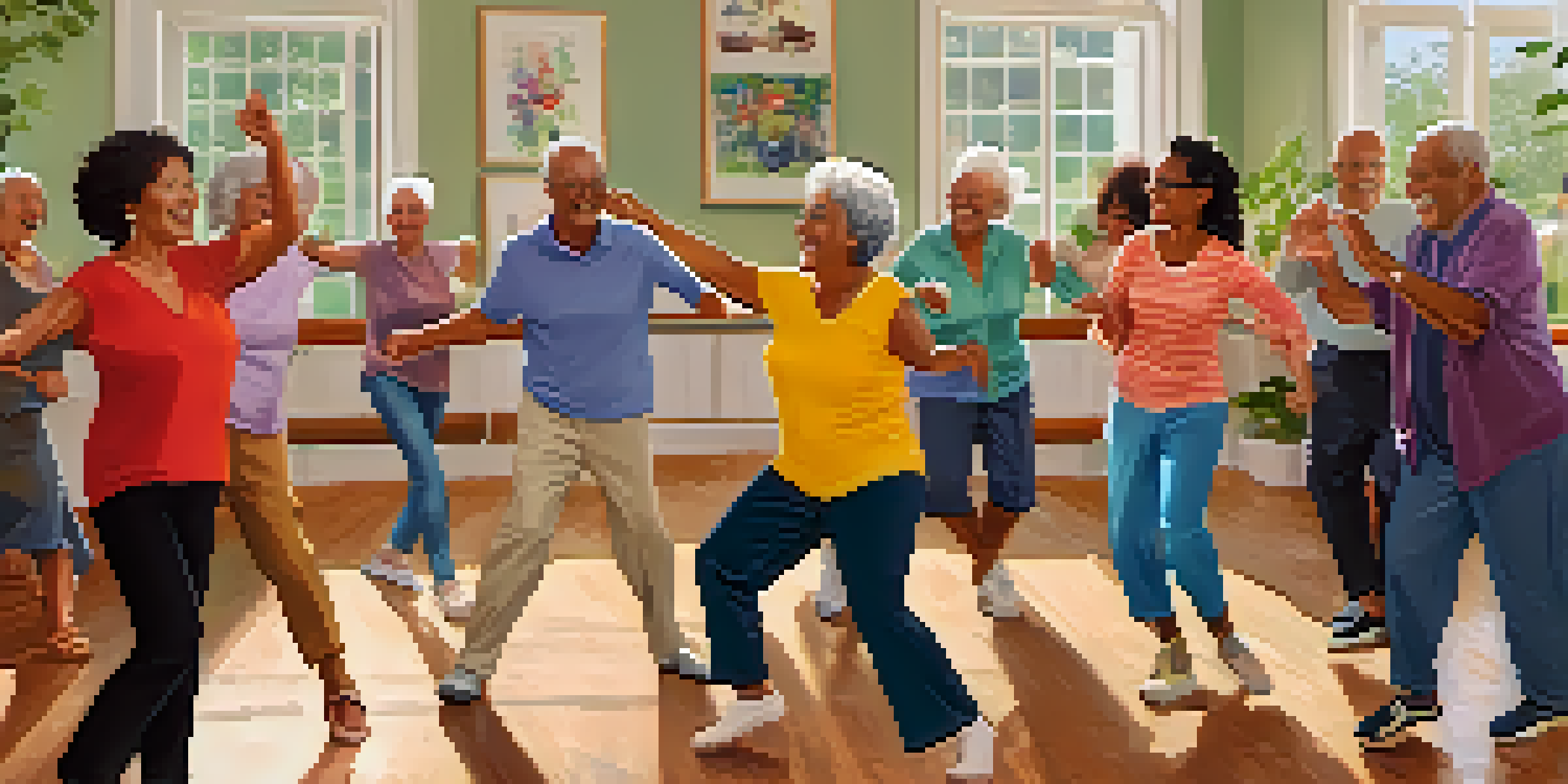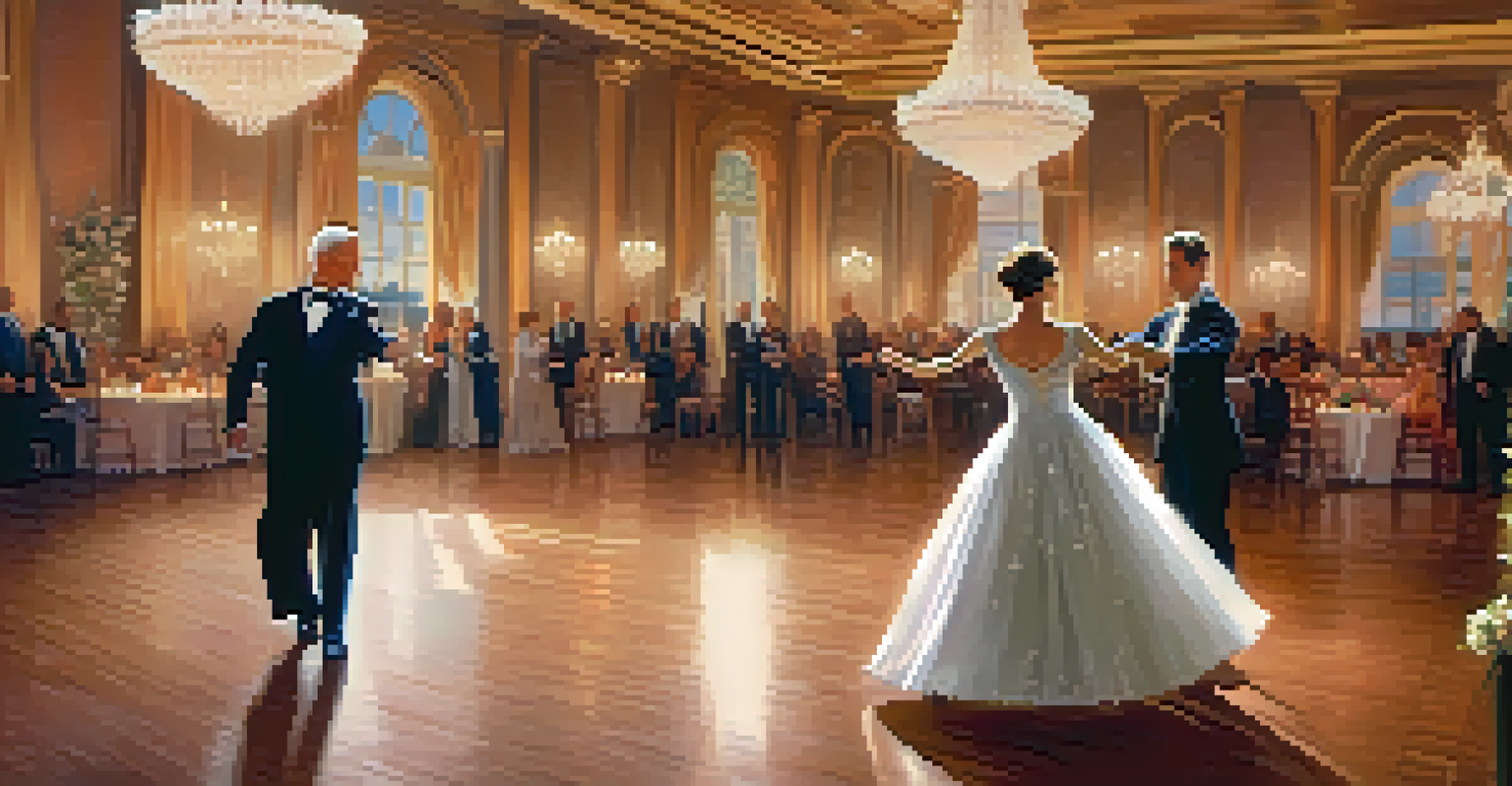The Benefits of Dance for Seniors: Movement and Wellness

Dance: A Fun Way to Stay Active and Engaged
Dance is not just about rhythms and moves; it's an exciting way for seniors to stay active. Engaging in dance offers a blend of physical activity and social interaction, making it enjoyable and beneficial. Whether it's a lively salsa or a gentle waltz, the fun of dancing keeps participants coming back for more, encouraging consistent movement.
Dance is the hidden language of the soul.
Moreover, dance classes often serve as a social hub, bringing together people with similar interests. This sense of community can have a profound effect on mental health, fostering friendships and reducing feelings of loneliness. When seniors dance together, they not only exercise but also share laughter and create lasting memories.
In essence, dance provides a holistic approach to staying active. It combines fitness and socialization, making it an ideal choice for seniors looking to enhance their overall quality of life.
Boosting Physical Health Through Dance
Regular dance practice comes with a plethora of physical health benefits that are especially important for seniors. It helps improve cardiovascular health, balance, flexibility, and strength. Just imagine how a simple twist or turn can engage multiple muscle groups and keep those joints moving smoothly.

Additionally, dance is a low-impact form of exercise, which makes it easier on the joints compared to other activities. This means seniors can enjoy the benefits of physical activity without the risk of injury often associated with high-impact workouts. It's like a gentle embrace for the body, promoting movement while minimizing strain.
Cognitive Benefits of Dancing
Learning dance routines engages the brain, promoting memory retention and cognitive flexibility.
Ultimately, the physical health benefits of dance extend beyond just fitness; they contribute to longevity and a better quality of life. Staying active through dance can lead to a more vibrant, energetic lifestyle as seniors age.
Enhancing Mental Well-Being with Dance
Dance is not only a physical workout; it also offers significant mental health benefits. Engaging in dance releases endorphins, often referred to as 'feel-good' hormones, which can elevate mood and reduce feelings of anxiety or depression. This is especially crucial for seniors who may face isolation or health challenges.
To dance is to be out of yourself. Larger, more beautiful, more powerful. You are not just in the world, you are the world.
Moreover, learning new dance steps and routines can help keep the brain active. The mental engagement of remembering choreography and coordinating movements can sharpen memory and cognitive function. It’s like a fun puzzle that keeps the mind engaged and alert.
In short, dance acts as a natural antidote to stress and mental fatigue. It encourages seniors to express themselves creatively while boosting their overall emotional well-being.
Improving Balance and Coordination Through Dance
One of the key benefits of dance for seniors is its ability to improve balance and coordination. As we age, maintaining stability can become a challenge, leading to falls and injuries. Dance, with its various movements and rhythms, encourages seniors to work on their balance in a fun and engaging way.
Incorporating dance into a routine can enhance proprioception, which is the body’s awareness of its position in space. By practicing different dance styles, seniors can develop better coordination and agility, making everyday activities easier and safer. It’s like giving their bodies a tune-up to ensure everything runs smoothly.
Dance Enhances Physical Health
Regular dance practice improves cardiovascular health, balance, and flexibility while being a low-impact exercise.
Ultimately, better balance and coordination not only enhance the ability to dance but also contribute to greater independence. With improved stability, seniors can feel more confident navigating their environment.
Social Benefits of Dance for Seniors
Dance is inherently social, providing a wonderful opportunity for seniors to connect with others. Whether in a class setting or at a social dance event, the communal aspect of dance helps build relationships and fosters a sense of belonging. It’s like a warm hug from the community.
These social interactions can significantly reduce feelings of loneliness, which is common among seniors. Sharing a dance with a partner or joining a group class creates bonds that can lead to lasting friendships. This social engagement is crucial for emotional health and can lead to more active lifestyles.
In summary, the social benefits of dance extend far beyond the dance floor. By connecting with others, seniors can enhance their emotional well-being and create a vibrant social life.
Cognitive Benefits: Dance as a Learning Experience
Dance can also serve as a stimulating mental exercise for seniors. Learning new dance steps or routines challenges the brain, promoting cognitive flexibility and memory retention. It's like a workout for the brain, keeping it sharp and engaged.
The process of memorizing choreography and coordinating movements requires focus and concentration, which can be beneficial for cognitive health. This mental stimulation can help delay cognitive decline, making dance an essential part of a healthy lifestyle.
Social Connections Through Dance
Dance fosters social interaction, helping seniors build friendships and reduce feelings of loneliness.
So, not only does dance provide physical benefits, but it also nurtures mental agility. It’s a comprehensive form of exercise that nourishes both body and mind.
Finding the Right Dance Style for Seniors
With so many dance styles to choose from, it’s essential to find the right fit for seniors. Styles like ballroom, line dancing, and even gentle Zumba can cater to different preferences and physical abilities. The key is to select a style that resonates with the individual, making the experience enjoyable.
It’s important to start slow, especially if someone is new to dancing. Many community centers and dance studios offer beginner classes specifically designed for seniors, ensuring that everyone feels comfortable and confident on the dance floor. This supportive environment encourages participation and fosters a love for dance.

Ultimately, finding the right dance style can make all the difference. When seniors enjoy what they’re doing, they’re more likely to stick with it and reap all the wonderful benefits dance has to offer.
Conclusion: Embrace Dance for a Healthier, Happier Life
In conclusion, the benefits of dance for seniors are manifold, impacting physical, mental, and social well-being. By embracing dance as a regular activity, seniors can enjoy a more vibrant, connected, and active lifestyle. It’s not just about the steps; it’s about the joy and fulfillment that dancing brings.
Dance offers a unique combination of exercise and social interaction, making it an ideal choice for seniors looking to enhance their quality of life. With every twirl and every step, they are not just dancing; they are celebrating life.
So let’s encourage our seniors to put on their dancing shoes and join the rhythm of life. After all, dancing isn’t just a hobby; it’s a pathway to wellness and happiness.